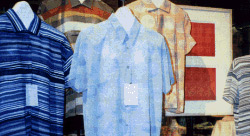Innovative Textile Designs Result from Mathematica Physics Visualizations
- Symbolic
- Numeric
- Graphic
- Notebook
- Programming
Buyer beware! When shopping for an upscale blouse in the most prestigious department stores in Japan, you might encounter Mathematica and not even know it. That's because the very fabric that makes that shirt might have been designed by Igor Bakshee, an avid Mathematica aficionado and user.
Bakshee, a physicist, got into fabric design when doing research on statistical radiophysics in Science University of Tokyo. His design work started with a routine application of a particular type of stochastic processes, the so-called 1/f fluctuations. From there, the transition from physicist to artist was so fast that Bakshee was soon doing design for several major Japanese textile companies. Bakshee's work became more and more in demand, and he used Mathematica to create designs for everything from blouses to gift wrap to office wall hangings to fine art prints. His work became so popular, it was even noticed by the folks at Wolfram Research, and we liked his work so much we hired him!
Get started with Wolfram technologies, or work with us to apply computational expertise to your projects.
Questions? Comments? Get in touch: 1-800-WOLFRAM, or email us »









